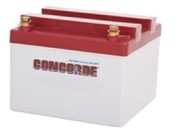Mon, Jul 26, 2010
Concorde Battery Discusses Parasitic Drain
 Concorde recently issued Technical Bulletin No. 10 "Parasitic
Drain", in response to questions throughout the aviation community
about the effect of parasitic drain on battery state of
charge. A parasitic drain is an electrical load that takes
power from the battery even when the Master Switch or Battery
Switch is Off. Examples of loads that cause parasitic drain
include clocks, lights, relays, current sensors and power
monitoring circuits. If an aircraft is inactive for a length
of time, depending on the magnitude of the load, the battery may be
depleted within weeks or even days.
Concorde recently issued Technical Bulletin No. 10 "Parasitic
Drain", in response to questions throughout the aviation community
about the effect of parasitic drain on battery state of
charge. A parasitic drain is an electrical load that takes
power from the battery even when the Master Switch or Battery
Switch is Off. Examples of loads that cause parasitic drain
include clocks, lights, relays, current sensors and power
monitoring circuits. If an aircraft is inactive for a length
of time, depending on the magnitude of the load, the battery may be
depleted within weeks or even days.
Skip Koss, Vice President of Marketing says, "When an aircraft
is not in service, a parasitic drain will deplete the battery's
state of charge unless the drain is disconnected." Mr. Koss
explains, "I am concerned about the increasing number of aircraft
affected by parasitic drain which can diminish emergency capacity
reserves and compromise the safety of pilots and passengers."
Parasitic loads are present in most modern day aircraft.
They are generally low in amperage but because they are
continuously present, if an aircraft is inactive for an extended
period of time, they can deplete the battery's capacity and cause
the plates to sulfate. Sulfated plates make the battery
harder to recharge and over time can lead to a battery that is no
longer airworthy and ultimately, premature failure. One of
the inherent dangers is that a battery without enough emergency
power reserve can often still start the engine(s). A battery
that is no longer airworthy can also cause an AOG event with
unexpected expenditures for obtaining an urgent replacement,
freight, installation and possibly costs for transportation back
and forth to a hotel for overnight accommodations.

To preserve the life of your battery, Concorde recommends
measuring the parasitic drain which can be easily accomplished
using a standard digital multimeter (DMM) equipped with both 10 Amp
and milliampere jacks for test leads. Details for this
procedure and a formula to calculate the depletion rate can be
found in Technical Bulletin No. 10 "Parasitic Drain" on the
Literature, Manuals and Technical page of the Concorde Battery
website. In some aircraft, modifications can be made to reduce or
eliminate the parasitic drain however, the airframe manufacturer
should be contacted for information on this subject.
Concorde says the best practice to protect an inactive aircraft
battery from parasitic drain is to disconnect it, if possible!
More News
Touchdown Zone Lighting Two rows of transverse light bars located symmetrically about the runway centerline normally at 100 foot intervals. The basic system extends 3,000 feet alon>[...]
“Discovery and innovation are central to our mission at Virgin Galactic. We’re excited to build on our successful record of facilitating scientific experiments in subor>[...]
"We are reaching out to you today on behalf of the Popular Rotorcraft Association because we need your help. We are dangerously close to losing a critical resource that if lost, wi>[...]
UAS Traffic Management (UTM) The unmanned aircraft traffic management ecosystem that will allow multiple low altitude BVLOS operations and which is separate from, but complementary>[...]
Aero Linx: Society of Aviation and Flight Educators (SAFE) SAFE is a member-oriented organization of aviation educators fostering professionalism and excellence in aviation through>[...]
 ANN's Daily Aero-Term (05.02.24): Touchdown Zone Lighting
ANN's Daily Aero-Term (05.02.24): Touchdown Zone Lighting Aero-News: Quote of the Day (05.02.24)
Aero-News: Quote of the Day (05.02.24) Aero-News: Quote of the Day (05.03.24)
Aero-News: Quote of the Day (05.03.24) ANN's Daily Aero-Term (05.03.24): UAS Traffic Management (UTM)
ANN's Daily Aero-Term (05.03.24): UAS Traffic Management (UTM) ANN's Daily Aero-Linx (05.03.24)
ANN's Daily Aero-Linx (05.03.24)




